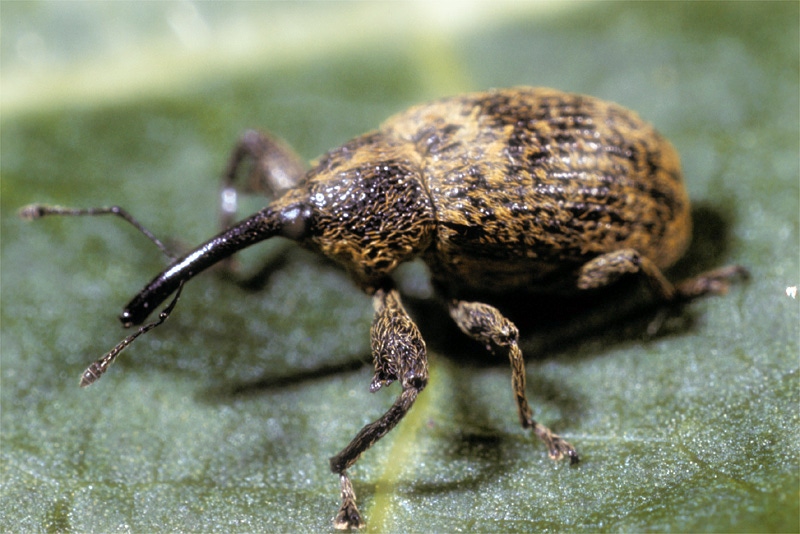
The success of the Boll Weevil Eradication program has resulted in a $2.3 billion advantage for the Texas cotton industry. And, combined with widespread adoption of transgenic crops, the eradication program allowed farmers to significantly reduce the number of pesticide applications they make and to increase yields by some 30 percent.
That translates into an advantage for cotton farmers and society in general with benefits to rural economies and environmental improvements.
It’s been a long, hard fight against the boll weevil, says Dr. Charles Allen, Texas AgriLife Extension specialist/IPM coordinator.
Allen provided an historical overview of the boll weevil problem during the opening session of the recent Texas Plant Protection Association’s 25th annual conference in Bryan, Texas.
“It’s been a 120-year war with Texas and southern cotton farmers,” Allen said, “beginning in 1892, when the weevil first came across the Rio Grande. Some said the boll weevil made the most significant impact on the south since the Civil War. Initially, farmers had nothing to fight the boll weevil with and losses were as high as 80 percent.”
He said the boll weevil moved from the Lower Rio Grande Valley to the Atlantic Ocean in 30 years. “It was a slow moving natural disaster that destroyed the economy of the South.”
Early efforts to control the devastating pest included attempts to shorten the cotton growing season. Short-season varieties and adding fertilizer to encourage early fruiting and boll set were part of the program. Stalk destruction was also a recommendation included in “the government method.”
“It was a rudimentary effort,” Allen said, with limited success. “With nothing but a hoe or a horse-drawn plow, stalk destruction was hard work and almost impossible.”
If you are enjoying reading this article, please check out Southwest Farm Press Daily and receive the latest news right to your inbox.
Technology improved the odds. As farmers began to use tractors and V-plows they were more effective. “Tractors with PTO and shredders also helped destroy cotton stalks.”
Insecticides also moved into cotton fields, beginning around 1917 with calcium carbonate and then DDT in 1945. Emulsifiable concentrates came along in 1946, improving application efficiency over the dust products farmers had relied on.
Carbaryl and permethrin added to the arsenal of insecticides and as farmers began to rely on insecticides “the other integrated approaches vanished,” Allen said.
Those early insecticides, mostly dusts, were used without much regard “for user safety. They also created environmental problems, resistance, resurgence and related issues.”
He said when Rachel Carson published her landmark environmental work Silent Spring in 1962, the general public became more aware of ecological issues and the effect of pesticides. That attention, Allen said, “led to creation of the Environmental Protection Agency. That was also the beginning of integrated pest management and scouting systems. IPM tactics and economic thresholds came about in the late 1960s and 1970s.”
Allen said another benchmark event, eradication of the screw worm, paved the way for a similar effort on boll weevils. The pests were different and required different approaches. “But success of the screw worm eradication program showed that it could be done,” he said.
That encouraged increased funding and testing for a boll weevil eradication program, which began in 1983.
Allen showed a chart that depicted the beginning of the program, in a small corner of Virginia and North Carolina and then spreading south into the Carolinas, Georgia and the Mid-South with simultaneous efforts in California and Arizona, then into Oklahoma, New Mexico and Texas.
After setbacks and false starts, the program was successful across the Cotton Belt and in 2013 only a small area of boll weevil activity is left in the Lower Rio Grande Valley. “And we’re making good progress there.”
Challenges remain for pest management, however, as farmers adopt technology, new systems and new ways of dealing with pests, some of which may make them more vulnerable to infestations.
Allen said nearly every part of insect management used now is “a preventive approach in nearly every field.” And resistant pests are showing up, beginning in the Midwest around 2009 and with pests that do not show an almost 100 percent control rate with genetically modified varieties or hybrids.
“We now have more reliance on technology but also more vulnerability. Field–specific programs are no longer well-used.” Instead, farmers are relying on transgenic varieties, and seed treatments on a whole-farm system.
Allen is concerned about weed and insect resistance as well as invasive pests—weeds, cotton seed bugs, sorghum/sugarcane aphids, among others. He says many of these are brought in as a result of “globalization of agriculture,” possibly through the South Texas ports.
He sees other “storm clouds on the horizon,” including the population growth estimates that could mean from 2 billion to 4 billion more people on earth by 2050.
“We have to be farming at a very high level,” to meet that demand, he said. “We must have a sense of urgency; we can’t just sit back and think we will be OK. Agriculture must take command.”
Higher demand for food and fiber will result in higher commodity prices. “We have to rebuild our agriculture infrastructure and we also have to have more people trained in field-specific agricultural management.”
The boll weevil may be on its way to defeat; ag technology may have allowed farmers to increase yield and reduce pesticide use, but farmers continue to face the daunting task of earning a living while providing life’s essentials to the world. And water, Allen said, will be a huge factor for continued production of adequate food supplies.
More from TPPA:
Agriculture faces daunting challenges in coming years
About the Author(s)
You May Also Like






